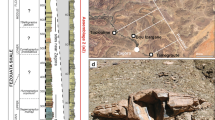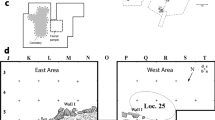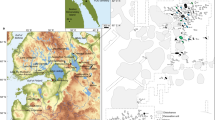Abstract
Concentrations of fossil hardparts are common features of the stratigraphical record and are preferred collecting sites for most palaeontological data. Nonetheless, most investigations into the nature of the fossil record have analysed the biasing effects of selective hardpart transport and destruction1,2 rather than the consequences of the concentration process itself. Genetic classification is discouraged by the diverse origins of skeletal accumulations, which range from predator gastric residues to shelly shoals and biostratigraphically condensed deposits; concentrations can thus form over time intervals of a few minutes to hundreds of thousands of years. I show here that the close association of shell beds with stratigraphical discontinuities in Miocene shallow marine deposits of Maryland3,4 provides the basis of a model of skeletal accumulation cast entirely in terms of changes in net sedimentation. This simple sedimentological model is a surprisingly powerful predictor of post-mortem bias and ecological composition of fossil assemblages, suggesting that fossil-rich and fossil-poor strata are qualitatively different, both as repositories of palaeontological information and as settings for biotic interactions. Moreover, the apparent primary importance of rates of sedimentation in skeletal accumulation—despite emphasis usually placed on rates of hardpart input—suggests a new approach to inferring the detailed dynamics of sediment deposition and erosion in the formation of stratigraphical sequences.
This is a preview of subscription content, access via your institution
Access options
Subscribe to this journal
Receive 51 print issues and online access
$199.00 per year
only $3.90 per issue
Buy this article
- Purchase on Springer Link
- Instant access to full article PDF
Prices may be subject to local taxes which are calculated during checkout
Similar content being viewed by others
References
Dodd, J. R. & Stanton, R. J. Jr Paleoecology, Concepts and Applications (Wiley, New York, 1981).
Brehrensmeyer, A. K. & Kidwell, S. M. Paleobiology 11, 105–119 (1985).
Kidwell, S. M. 2nd N. Am. Paleont. Conv. Proc. 1, 295–300 (1982).
Kidwell, S. M. Paleobiology (in the press).
Barrell, J. Bull. geol. Soc. Am. 28, 745–904 (1917).
Campbell, C. V. Sedimentology 8, 7–26 (1967).
Tipper, J. C. Nature 302, 696–698 (1983).
Brinkmann, R. Abh. K. Ges. Wiss. Gottingen n.F. 13, 1–249 (1929).
Kidwell, S.M. & Jablonski, D. in Biotic Interactions in Recent and Fossil Benthic Communities (eds Tevesz, M. J. S. & McCall, P. L.) (Plenum, New York, 1983).
Kidwell, S. M. & Aigner, T. in Sedimentary and Evolutionary Cycles (eds Bayer, U. & Seilacher, A.) (Springer, Berlin, 1985).
Sylvester-Bradley, P. C. in Concepts and Methods of Biostratigraphy (eds Kauffman, E. G. & Hazel, J. E.) (Dowden, Hutchinson and Ross, Stroudsburg, 1977).
Williamson, P. G. Nature 293, 437–443 (1981); 296, 611–612 (1982).
Shattuck, G. B. in The Miocene Deposits of Maryland (eds Clark, W. B., Shattuck, G. B. & Dali, W. H.) (Maryland Geological Survey, 1904).
Kelley, P. H. J. Paleont. 57, 581–598 (1983).
Kidwell, S. M. Am. Ass. petrol. Geol. Mem. 36, 37–58 (1984).
Author information
Authors and Affiliations
Rights and permissions
About this article
Cite this article
Kidwell, S. Palaeobiological and sedimentological implications of fossil concentrations. Nature 318, 457–460 (1985). https://doi.org/10.1038/318457a0
Received:
Accepted:
Issue Date:
DOI: https://doi.org/10.1038/318457a0
This article is cited by
-
Morphological disparity in extant and extinct sepiid phragmocones: morphological adaptions for phragmocone strength compared to those related to cameral liquid emptying hypotheses
Swiss Journal of Palaeontology (2022)
-
Using Trampling Modification to Infer Occupational Intensity During the Still Bay at Blombos Cave, Southern Cape, South Africa
African Archaeological Review (2018)
-
Taxonomic and taphonomic signatures of mollusk shell concentrations from coastal lagoon environments in Belize, Central America
Facies (2016)
-
Terrestrial and maritime taphonomy: differential effects on spatial distribution of a Late Pleistocene continental drowned faunal bone assemblage from the Pacific coast of Chile
Archaeological and Anthropological Sciences (2016)
-
Taphonomy and paleoecology of Cenomanian oysters from the Musabaa Salama area, southwestern Sinai, Egypt
Geosciences Journal (2015)
Comments
By submitting a comment you agree to abide by our Terms and Community Guidelines. If you find something abusive or that does not comply with our terms or guidelines please flag it as inappropriate.



